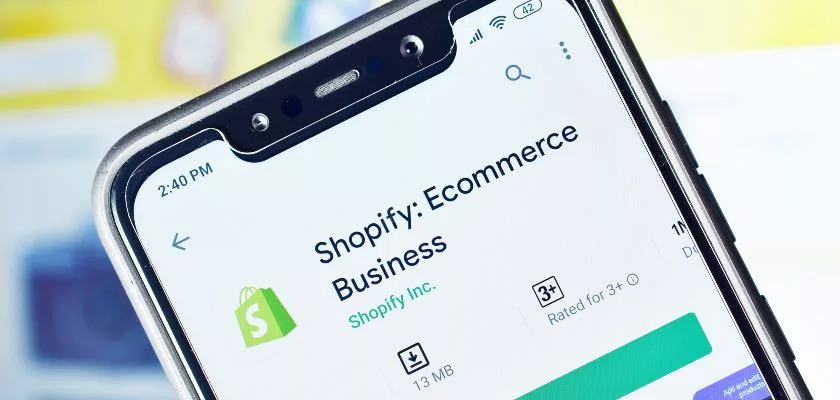Off-the-Chart Shopify Marketing Strategies with Real-life Campaign Examples
Imagine a world where adults devoted an average of 485 minutes (eight hours and five minutes) per day to consuming digital media. And yes, this world is real; this world is ours! In this circumstance, those seeking to grow...

Imagine a world where adults devoted an average of 485 minutes (eight hours and five minutes) per day to consuming digital media. And yes, this world is real; this world is ours! In this circumstance, those seeking to grow their e-commerce business & Shopify stores should hitch horses with digital media. Join us as we discover the best digital marketing efforts for Shopify.
Digital Marketing for Shopify – As a “Big Gun”
Let’s begin with an astonishing fact: There are currently more than 4.12 million active Shopify stores. That means differentiating from other e-commerce businesses and shops is not a picnic – sad but true. Even so, you have digital marketing activities tailored for Shopify!
As a global e-commerce & online selling platform, Shopify takes nourishment from digital marketing strategies – especially for maximizing online presence, promoting products, and reaching a vast audience of potential customers.
It wouldn’t be wrong to say that digital marketing is the most acute tool for Shopify store owners to drive targeted traffic to their online stores. Through widely used digital marketing strategies like search engine optimization, pay-per-click advertising, and social media targeting, owners can attract qualified leads. What’s more, contrary to traditional marketing, digital marketing activities and related tools allow users to track their ads results and see what is working and what is not.
When it comes to conversion rates, digital marketing helps Shopify store owners operate tactics such as A/B testing, product recommendations, and effective content marketing methods, which result in improving the user experience and increasing the likelihood of visitors making a purchase.
More specific info? Keep reading.
Best Marketing Strategies for Shopify
While the importance of price and product is evident in online shopping, achieving success in the digital realm also requires a 360-degree marketing strategy and the assistance of professional agencies. Just before taking a look at our quick list of essentials of Shopify marketing strategies, discover the best Shopify agencies in the USA.
Live Streaming + FOMO (Fear of Missing Out)
In some cases, digital marketing strategies for lead generation are grounded in psychological phenomena. As an example: FOMO, or Fear of Missing Out, is a psychological phenomenon referring to the anxiety individuals experience when considering they might miss out on an exciting opportunity. In terms of e-commerce and live streaming, FOMO is a powerful marketing tactic urging customers to make faster purchasing decisions.
Live streaming events have a time-bound nature, and customers may fear missing out on exclusive deals or limited-time offers, which can drive them to make quicker purchasing decisions. So, it’s a great call for Shopify shop owners to take advantage of life streaming and FOMO at the same time!
Search Engine Optimization (SEO)
According to a blog post released by Shopify, a significant portion of your store’s website traffic (35%) and revenue (33%) originates from search engine results pages (SERPs).
We also know that effective local SEO strategies allow shop owners to acquire a competitive advantage by surpassing the other shops in search results, grabbing a larger market share, and attracting more customers.
In addition to that, SEO provides long-term sustainability, as the efforts invested in optimization deliver ongoing benefits while driving organic traffic, targeting a specific group of audience, building trust and credibility, and enhancing the user experience. By prioritizing SEO, it is possible to optimize Shopify stores to thrive in the digital landscape.
Pay-per-Click (PPC) Advertising
Back to basics for a second: PPC advertising allows users to target specific keywords, demographics, interests, and buying behaviors through the platforms like Google, Facebook & Instagram Ads, and so on. When it comes to e-commerce activities, PPC has another and more consequential meaning due to its geo-targeting feature.
The geo-targeting option helps local or regionally focused businesses display their ads exclusively to people in specific locations; this kind of targeting refers to making the ads more relevant and greatly increasing the chance of attracting local customers.
In addition to the geo-targeting option, pay-per-click strategies equips businesses with budget control, allowing them to set limits based on campaign performance. The performance metrics, such as clicks, impressions, conversions, and ROI, provide valuable insights for data-driven decisions, ad optimization, and campaign efficiency.
Long story short, PPC’s features make it an essential tool for Shopify websites and e-commerce businesses aiming to drive targeted traffic, boost brand visibility, and achieve tangible business growth.
Affiliate Marketing
In the most basic words, affiliate marketing is a performance-driven approach that leverages partnerships to drive sales and leads, benefiting both businesses and affiliates in the e-commerce ecosystem. What’s more, affiliates acquire commissions for each sale, lead, or action generated through their marketing efforts.
E-commerce – more specifically for Shopify-based marketing actions can be furnished with this approach. So much so that, shop owners can tap into various audiences that might not be reached through traditional marketing steps, resulting in qualified leads & potential sales.
How come? Just like influencer marketing, affiliates promote the products by sharing them on their blogs, social media platforms, websites, and the other digital channels. Each time clicks on the affiliate’s unique tracking link and makes a purchase or performs the desired action on the merchant’s website, the affiliate earns a commission.
Referral System
In contrast to targeting-based digital marketing efforts for Shopify stores, referral marketing relies on word-of-mouth and personal recommendations. When someone makes a purchase or signs up based on the referral, the first customer who made the recommendation typically acquires a reward or incentive – like coupons, discounts or gift cards.
Even though the referral system is not a new way, we know that a great number of people tend to trust their friends’ recommendations and experiences. By optimizing the networks and relationships of satisfied customers, businesses can tap into new potential customers cost-effectively and organically.
In other words:
“Referral marketing is the best way to acquire new customers who are already pre-sold on your product or service.”
Mike Volpe, CMO at HubSpotCross-Promotion
The two-word answer for those seeking to build credibility while increasing sales is “cross-promotion.”
Cross-promotion for Shopify addresses an e-commerce strategy where two or more businesses team up to promote each other’s products or services.
Cross-promotion can be carried out via various media, such as social media shout-outs, joint email marketing campaigns, blog posts, or live-streaming events. The objective is to improve each other’s platforms and audiences to expand reach, increase brand visibility, and drive more traffic and sales to both Shopify stores involved in the partnership. As widely known, increasing ecommerce website traffic is another story.
Shopify Marketing Campaign Examples
After providing you with the best Shopify marketing strategies, it’s now time for real-life examples to illustrate their practical implementation.
Video Marketing – Patagonia
Patagonia, known for its high-quality products & environmental activism, usually uses video marketing to achieve several objectives in Shopify.
Referral Campaign – MeUndies
MeUndies has carried out a great referral campaign: “Your friends get 20%off and you get 20 off after their first purchase.”
Social Media Advertising – ReveBoutique
ReveBoutique launched a holiday-themed campaign on Instagram, Facebook, and their homepage. The brand’s campaign was a win, and it helped them boost sales during the holiday season.
Storytelling – Nordstrom Trunk Club
Trunk Club nailed it with their “The Gift of Style” campaign, showcasing videos of both men and women receiving top-notch styling from Trunk Club’s own expert stylists. The campaign hit the bullseye, creating a buzz around Trunk Club’s styling service and ultimately driving up their sales.
FOMO (Fear of Missing Out) – goodfair
goodfair, a thrift shop built on Shopify with a strong focus on combating climate change, sets a remarkable example for creating FOMO (fear of missing out). During special occasions, the brand offers time-limited discounts, motivating their followers to act swiftly and make purchasing decisions without hesitation.
Another example: cocofloss
Affiliate Marketing – Allbirds
Allbirds and Olivia Rubin, renowned for their dedication to sustainability and comfort, joined forces in 2022 to produce a captivating limited-edition collection of sneakers crafted from recycled materials. The collaboration struck a chord with consumers, proving to be a tremendous success, and effectively heightened awareness of both brands’ shared commitment to sustainable practices
Cross-Promotion – Velasca Milano X Alfa Romeo
Velasca Milano, an Italian footwear brand admired for its chic and eco-conscious shoes, partnered with Alfa Romeo, a renowned Italian car brand celebrated for its high-performance and luxurious vehicles. In 2022, the two brands joined forces to create a limited-edition shoe collection inspired by the Alfa Romeo Giulia GTA. A captivating social media campaign accompanied the collection’s launch, showcasing the Alfa Romeo Giulia GTA alongside the shoes, demonstrating their harmonious fusion, and emphasizing the striking similarities shared by both esteemed brands.
More? Check out other creative Shopify ecommerce websites.

 AbJimroe
AbJimroe 













_2.jpg)



















